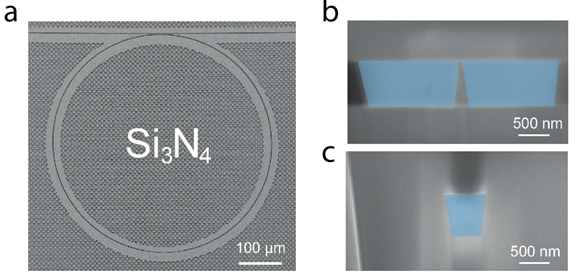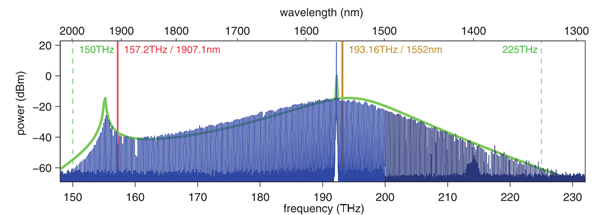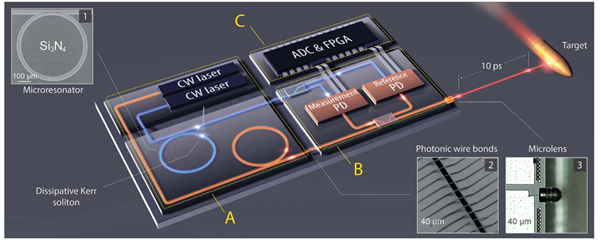Introduction:
Our work is focused on the generation of optical frequency comb in photonic chip-based optical microresonators. Microresonators represent a unique platform for on-chip nonlinear optics, as they allow to efficiently confine light in a small volume of the resonator medium. Given high quality (Q) factors of the microresonator, the light can reach extremely high intracavity intensities, thus enabling optical nonlinear effects. In our lab we are working with high-Q planar microring resonators (Q > 106), made of silicon nitride (Si3N4) – a Kerr-nonlinear and widely transparent material, which has a widespread usage in photonics and electronics. When such microresonator is driven with a strong continuous-wave (CW) laser, the four-wave mixing processes can be initiated providing the generation of multiple equally-spaced optical frequencies – an optical frequency comb [1]. The frequency spacing is generally defined by the free spectral range of the cavity and can easily range from a GHz-level to several THz. The optical frequency combs generated in on-chip microresonators has a number of important advantages, including their exceptionally small, chip-scale footprint, high repetition rates, high conversion efficiency and CMOS-compatibility allowing for mass-volume production on a standard microfabrication equipment as well as easy integration with other optical components or even optoelectronic systems on a single chip.
Microfabrication and optical photonic design:
A fundamental part of our research that underpin almost every project on the chip-scale frequency combs is microfabrication. In the group, we developed and constantly improving several fabrication processes aimed for the production of the Si3N4 low-loss waveguides and high-Q microresonators [2-4]. Moreover, we are continuously working on the development of new fabrication approaches and are seeking for alternative nonlinear materials in order to boost the fabrication control, quality and performance of our microresonator devices. A significant part of our microfabrication process consists of the microresonator design and its optimization, which includes the engineering of the dispersion properties, optimization of the chip and microresonator coupling and improving the quality factors [5-8]. These efforts are intendent to increase the general efficiency of our devices or adapt them for special applications, such as optical coherent communications or spectroscopy in order to outperform current and existing optical comb solutions.

Figure 1. Silicon nitride (Si3N4) microresonators with free spectral range of 100 GHz. (a). Scanning electronic microscop imae of the resonator and bus waveguide. (b) False-color chip crossection in cthe coupling region of the bus waveguide and microresonator. Silicon nitride is blue shaded. Silica is unshaded. (c) False-color chip crossection of the microresonator waveguide in the region of filtering section [6]
Dissipative Kerr solitons in optical microresonators:
Optical microresonators represent complex nonlinear systems, which enable the formation of optical frequency combs through the multiple cascaded four-wave-mixing processes. Our group has recently demonstrate that such optical combs can operate in a soliton regime, when intracavity waveform is spontaneously self-organised in an optical pulse circulating inside the cavity. Such intracavity pulses are called dissipative Kerr soliton (DKS), and they rely on the double balance between dispersion and nonlinearity as well as CW pump and cavity losses that is achieved in the microresonator [2, 9]. Our group is deeply interested in the understanding of different aspects of DKS dynamics, including various approaches and techniques for their generation, control and characterization [10, 11]. We also study how dissipative Kerr solitons interact with various nonlinear, thermal and dispersive effects, or a combinations of thereof originating from the microresonator [11, 12]. Furthermore, due to complex stability diagram and intrinsic nonlinearity of the system, it possess a rich panel of stationary and non-stationary intracavity formations which are of high interest not only from the perspective of microresonator optical combs, but from the perspective of the fundamental dynamics of nonlinear systems operating far from the equilibrium [13-15]. Nowadays, the area of the DKS in optical microresonaotrs dynamics is actively evolving and still has a lot of unanswered questions.

Figure 2. Optical spectrum of the dissipative Kerr soliton emitting Cherenkov radiation in 190-GHz Si3N4 optical microresonator
Platform extension and applications:
Despite the fact that Dissipative Kerr solitons in microresonators is relatively young phenomenon, it has already demonstrated a huge potential for applications in various areas of technologies ranging from telecommunications to spectroscopy. During the previous years we have employed chip-scale DKS sources for self-referencing [16], also in a joined work with our collaborators from Karlsruhe Institute of technology (KIT) DKS optical combs were used for optical coherent communication and enabled data rates of more than 50 Tb/s [17]. Moreover, we have demonstrated that DKS pulses can be used for ultrafast distance measurements providing record-fast distance sampling with submicron precision [18]. Besides actual applications we are intensively working to extend our platform to new wavelength ranges [19, 20]. This would allow us to significantly broaden the range of available applications of the chip-scale frequency combs and reach the areas of biological and medical spectroimaging, molecular fingerprinting, optical coherence tomography and astronomical calibrations.

Figure 3. Artist’s view of DKS-based chip-scale LIDAR
References:
[1] Del’Haye, P., Schliesser, A., Arcizet, O., Wilken, T., Holzwarth, R. and Kippenberg, T.J., 2007. Optical frequency comb generation from a monolithic microresonator. Nature, 450(7173), p.1214.
[2] Brasch, V., Geiselmann, M., Herr, T., Lihachev, G., Pfeiffer, M.H., Gorodetsky, M.L. and Kippenberg, T.J., 2016. Photonic chip–based optical frequency comb using soliton Cherenkov radiation. Science, 351(6271), pp.357-360.
[3] Pfeiffer, M.H., Kordts, A., Brasch, V., Zervas, M., Geiselmann, M., Jost, J.D. and Kippenberg, T.J., 2016. Photonic Damascene process for integrated high-Q microresonator based nonlinear photonics. Optica, 3(1), pp.20-25.
[4] Pfeiffer, M.H., Liu, J., Raja, A.S., Morais, T., Ghadiani, B. and Kippenberg, T.J., 2018. Probing the loss origins of ultra-smooth Si3N4 integrated photonic waveguides. arXiv preprint arXiv:1802.08315.
[5] Brasch, V., Chen, Q. F., Schiller, S., & Kippenberg, T. J. (2014). Radiation hardness of high-Q silicon nitride microresonators for space compatible integrated optics. Optics express, 22(25), 30786-30794.
[6] Kordts, A., Pfeiffer, M.H., Guo, H., Brasch, V. and Kippenberg, T.J., 2016. Higher order mode suppression in high-Q anomalous dispersion SiN microresonators for temporal dissipative Kerr soliton formation. Optics letters, 41(3), pp.452-455.
[7] Pfeiffer, M.H., Liu, J., Geiselmann, M. and Kippenberg, T.J., 2017. Coupling ideality of integrated planar high-Q microresonators. Physical Review Applied, 7(2), p.024026.
[8] Liu, J., Raja, A.S., Pfeiffer, M.H., Herkommer, C., Guo, H., Zervas, M., Geiselmann, M. and Kippenberg, T.J., 2018. Double inverse nanotapers for efficient light coupling to integrated photonic devices. arXiv preprint arXiv:1803.02662.
[9] Herr, T., Brasch, V., Jost, J.D., Wang, C.Y., Kondratiev, N.M., Gorodetsky, M.L. and Kippenberg, T.J., 2014. Temporal solitons in optical microresonators. Nature Photonics, 8(2), p.145.
[10] Brasch, V., Geiselmann, M., Pfeiffer, M.H. and Kippenberg, T.J., 2016. Bringing short-lived dissipative Kerr soliton states in microresonators into a steady state. Optics express, 24(25), pp.29312-29320.
[11] Guo, H., Karpov, M., Lucas, E., Kordts, A., Pfeiffer, M.H., Brasch, V., Lihachev, G., Lobanov, V.E., Gorodetsky, M.L. and Kippenberg, T.J., 2017. Universal dynamics and deterministic switching of dissipative Kerr solitons in optical microresonators. Nature Physics, 13(1), p.94.
[12] Karpov, M., Guo, H., Kordts, A., Brasch, V., Pfeiffer, M.H., Zervas, M., Geiselmann, M. and Kippenberg, T.J., 2016. Raman self-frequency shift of dissipative Kerr solitons in an optical microresonator. Physical review letters, 116(10), p.103902.
[13] Lucas, E., Karpov, M., Guo, H., Gorodetsky, M.L. and Kippenberg, T.J., 2017. Breathing dissipative solitons in optical microresonators. Nature communications, 8(1), p.736.
[14] Lucas, E., Guo, H., Jost, J.D., Karpov, M. and Kippenberg, T.J., 2017. Detuning-dependent properties and dispersion-induced instabilities of temporal dissipative Kerr solitons in optical microresonators. Physical Review A, 95(4), p.043822.
[15] Guo, H., Lucas, E., Pfeiffer, M.H., Karpov, M., Anderson, M., Liu, J., Geiselmann, M., Jost, J.D. and Kippenberg, T.J., 2017. Intermode Breather Solitons in Optical Microresonators. Physical Review X, 7(4), p.041055.
[16] Brasch, V., Lucas, E., Jost, J.D., Geiselmann, M. and Kippenberg, T.J., 2017. Self-referenced photonic chip soliton Kerr frequency comb. Light: Science & Applications, 6(1), p.e16202.
[17] Marin-Palomo, P., Kemal, J.N., Karpov, M., Kordts, A., Pfeifle, J., Pfeiffer, M.H., Trocha, P., Wolf, S., Brasch, V., Anderson, M.H. and Rosenberger, R., 2017. Microresonator-based solitons for massively parallel coherent optical communications. Nature, 546(7657), p.274.
[18] Trocha, P., Karpov, M., Ganin, D., Pfeiffer, M.H., Kordts, A., Wolf, S., Krockenberger, J., Marin-Palomo, P., Weimann, C., Randel, S. and Freude, W., 2018. Ultrafast optical ranging using microresonator soliton frequency combs. Science, 359(6378), pp.887-891.
[19] Pfeiffer, M.H., Herkommer, C., Liu, J., Guo, H., Karpov, M., Lucas, E., Zervas, M. and Kippenberg, T.J., 2017. Octave-spanning dissipative Kerr soliton frequency combs in Si 3 N 4 microresonators. Optica, 4(7), pp.684-691.
[20] Karpov, M., Pfeiffer, M.H., Liu, J., Lukashchuk, A. and Kippenberg, T.J., 2018. Photonic chip-based soliton frequency combs covering the biological imaging window. Nature communications, 9(1), p.1146.